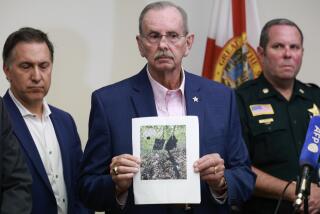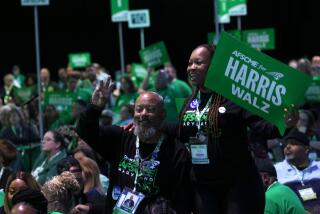GOP group: Democratic enthusiasm catches up with Republicans
- Share via
TAMPA, Fla. -- A new national survey of probable voters conducted for the GOP-affiliated Resurgent Republic has plenty to like if you’re a Mitt Romney backer -- pessimism about the economy, dissatisfaction with President Obama’s record and support for the Republican message on issues such as taxes and Medicare.
And, significantly, the survey from Republican pollster Whit Ayres found what he called a “significant deterioration” in Obama’s personal favorable rating, which now nearly equals his sub-50% job approval rating -- traditionally a negative omen for incumbents.
But for Haley Barbour, the former Mississippi governor and RNC chairman who’s still regarded as one of his party’s sharpest political minds, there is a shift in the other direction that was potentially concerning: Democrats have now caught up with Republicans when it comes to voter enthusiasm.
In a July survey for the group, 62% of Republicans and 49% of Democrats said they were “extremely enthusiastic” about voting, a sizable gap favoring the party out of power.
PHOTOS: Preparations for the GOP convention
But the latest data from August have Republicans with just a 1-percentage-point edge, 59% to 58% over Democrats, with independent voters lagging well behind.
The shift could be temporary, attributable to the approaching political conventions, as Ayres speculated. Even so, he said that with base voters canceling each other out, the race then comes down to those unenthusiastic independents, which the survey found leaning Romney by 8 percentage points. The survey overall had the race at 46% for Obama and 45% for Romney.
But if the race comes down to a battle over turnout versus one over persuasion, Republicans may have reason for concern. Barbour pointed to 2010, a year in which Republicans scored “the most massive repudiation of a president’s program in modern times,” and claimed the House of Representatives and a majority of governorships.
And yet even with the wind at the party’s back, Barbour -- then chair of the Republican Governors Assn. -- saw all five of the closest gubernatorial races won by the Democrats, in Illinois, Minnesota, Oregon, Vermont and Connecticut.
“It was not over enthusiasm. The enthusiasm gap was huge. It was over money and muscle,” Barbour said.
Barbour said he was heartened by the Wisconsin recall election, won by Gov. Scott Walker, where the GOP outperformed the Democrats, but nonetheless, “that’s something we have to be very, very, very cognizant of.”
“We used to have an advantage on the ground game -- get out the vote, the 72-hour program. They now have the advantage,” he said.
To that point, the Obama campaign has been investing heavily on a strategy that emphasizes a field program over paid media, even though they are also spending considerable sums on the latter.
“Here’s the truth: In the fall, after unprecedented media onslaught from both sides, people are going to walk out of their house, start talking to their families, neighbors, about what to do in this election. And our neighborhood teams will be a huge piece of that discussion,” an Obama campaign official said last week at a background briefing with reporters in Washington. “We think it’s a strategic advantage on the ground.... In every state we continue to be very clear about what we need to do to get to 50.1 [percent of the vote].”
That organizing effort faces headwinds, the Resurgent Republic data found. Fifty-four percent of voters said the country was not moving forward, intentionally using the single-word slogan for Obama’s campaign.
Of five key measures -- the economy, the federal budget, government’s ability to solve problems, America’s standing in the world, and safety from terrorism -- a plurality of voters said things were worse today than four years ago.
“If 2012 is a referendum on the incumbent, as almost all reelection campaigns are, President Obama remains in deep trouble,” the group said.
The survey was conducted from Aug. 16 to 22 with 1,000 probable voters, which included an oversample of 462 voters in 12 battleground states. The breakdown of the voter sample was 37% Democratic, 30% Republican, and 30% independent, with the remaining declining to state a party affiliation.
Follow Politics Now on Twitter and Facebook
Twitter: @mikememoli
More to Read
Get the L.A. Times Politics newsletter
Deeply reported insights into legislation, politics and policy from Sacramento, Washington and beyond. In your inbox twice per week.
You may occasionally receive promotional content from the Los Angeles Times.











